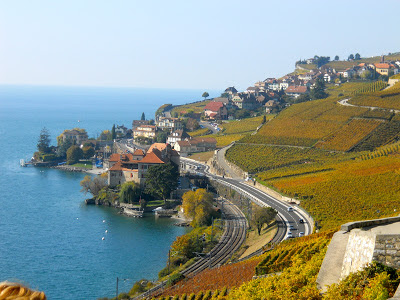The book was full of wonderful illustrations, such as the planting of a few wheat grains that the little red hen came across one day on the farm. Later in the story, she harvests the wheat and mills it into flour. All on her own, without the help of any of the other farm animals. Then there's that perfect kitchen in her "house", where she baked her delicious bread loaf and enjoyed it with her chicks, shutting out the other animals for being too lazy to help.
Come to think of it, that story was my first ever cookbook!
But back to eggs. They're a great source of protein and a very versatile pantry staple that combines beautifully with many other ingredients. We all have our favorite egg recipes - and mine are numerous - but I have two standouts that I make all the time.
 |
| Baked frittata with corn, blue cheese, onion and parsley |
The first recipe I learned from my grandmother, a talented home cook who took a simple approach to cuisine, with astonishing results. She fried her eggs in olive oil and spiced them with sumac, a common flavoring agent in Mid-Eastern kitchens. The zesty citrus taste of sumac cuts through the richness of the eggs which become crispy from frying in the oil.
The second recipe is a baked frittata that I put together from whatever I had in my fridge that day, and it became an instant hit. Sweet corn pairs fabulously well with the strong blue cheese, mixed with parsley and onions for an herby and earthy balance.
Sumac-Spiced Eggs
serves 4
8 fresh, organic eggs
3 Tbs extra virgin olive oil
1.5 Tbs sumac (found in specialty/health food stores)
salt to taste
In your favorite skillet - I prefer cast iron - heat oil until hot and begins to ripple. Crack eggs in the skillet. Sprinkle with salt and sumac and fry until the desired doneness is achieved. I cover the eggs and cook to over-medium, where the whites are firm but the yolk is still runny.
Baked Frittata with Corn and Blue Cheese
serves 4
4 fresh, organic eggs, beaten
1/2 bunch chopped Italian parsley (about a cup)
3/4 cup crumbled blue cheese
15-ounce (425 gr) can of corn (or 2 cups frozen corn, thawed)
15-ounce (425 gr) can of corn (or 2 cups frozen corn, thawed)
salt & fresh black pepper to taste
olive oil cooking spray
1 Tbs extra virgin olive oil
1 medium onion, chopped
Preheat oven to 375F (190C). Spray a 9-inch (23 cm) pie plate with cooking spray (or brush with a little olive oil). In a large bowl, whisk together the first five ingredients. Set aside. Sautee onion in oil until translucent and beginning to brown. Add to egg mixture and fold to combine. Pour mixture into pie plate and bake for 30 minutes. Remove frittata from oven and let rest for 5 minutes before serving.
 |
| Frittata cross-section |
Random Pic: "Turkey S & M"
 |
| My Thanksgiving turkey wrapped in Saran while it dry-brined. |











































